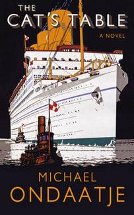The Cat's Table by Michael Ondaatje

Jonathan Cape, 2011. ISBN 9780224093620.
Recommended for Senior students. Aged eleven the boy Michael is sent
to England from Sri Lanka on the liner the Oronsay to reunite with
his mother. As an adult the narrator, now a novelist, (Ondaatje
claims that the book is fictional although it uses the 'colour and
locations' of autobiography) looks back on the voyage that became in
more ways than one a rite of passage. Also travelling on the boat
are a diverse range of characters, youngish women in search of
husbands, failed musicians, entertainers, thieves, children going to
England for school, rich old men looking for health and a manacled
prisoner.
Michael is allocated a dining table so far from the Captain's that
it is nicknamed the 'Cat's table' by fellow diners, who include a
mysterious tailor, Miss Lasqueti, with Foreign Office connections
and two other boys, Cassius and Ramadhin. Cassius, Michael and
Ramadhin make the ship theirs; they invade the lifeboats, lurk on
deck late at night when the prisoner is exercised and are used by a
thief to break into cabins. Although Ramadhin is constrained by
asthma Michael and Cassius are indomitable. In one terrifying
incident they chain themselves to the deck during a turbulent storm,
and have to weather the Captain's rage as a result.
The adult Michael realizes that the voyage took him from his safe
and idyllic childhood in Sri Lanka to the more turbulent years of
adult life. The author takes the reader forward in time to
Ramadhin's mysterious death, to Michael's marriage to his sister and
to the success of Cassius as a painter. We are then returned to the
voyage and the disastrous escape of the prisoner, which has been
contrived by the entertainers and in which the tailor and Miss
Lasqueti are implicit. The three children see death and understand
culpability, then land and go back to school. As an adult Michael
remembers and tries to make sense of the experience. The Jamesian
theme of innocence and experience is strongly established, the novel
being at its best in the descriptions of the boys' lives and
observations on the liner. The adult experiences are less
convincing, and the prisoner's story is melodramatic. However, the
novel would make an interesting comparison with texts dealing with
the themes of growing up and adolescence.
Jenny Hamilton